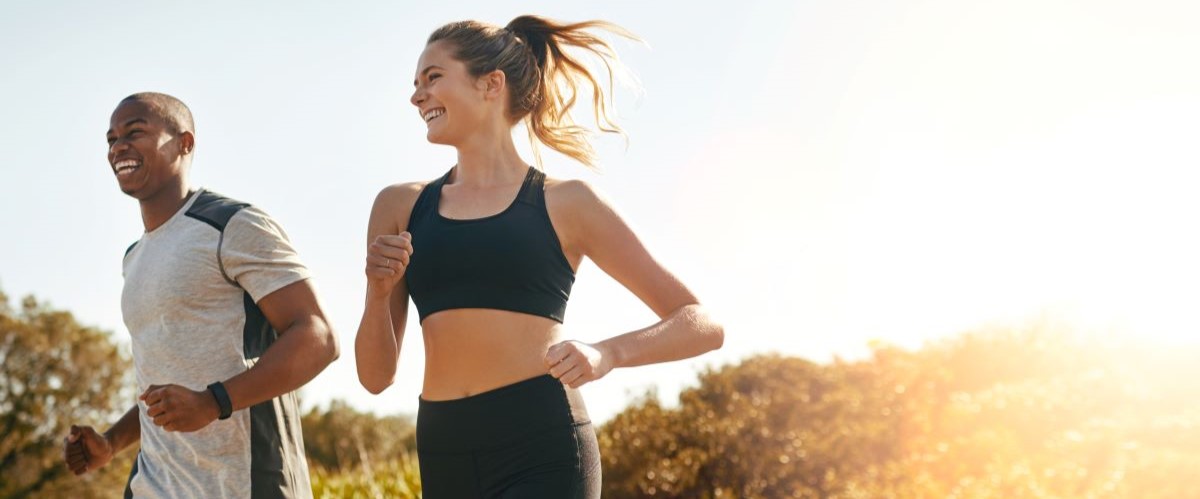The warning signs that your workout routine is not working for you
Keep in balance with your body, whether you’re gearing up for your first parkrun or upping your training routine, with these handy tips

With more of us exercising at home, staying healthy is now easier than ever – provided that we don’t overdo it.
The Covid-19 pandemic reminded us how vulnerable our health can be, and so, with lots of free time at home, many of us turned to at-home exercise while gyms and other facilities were out of action.
In fact, according to Sport England, 63% of us started getting active in the first six weeks of the pandemic.
The outbreak of Covid-19, and subsequent lockdowns, also permanently changed the fitness industry, with 72% of gyms now offering online workouts, up from just 25% in 2019, according to Bloomberg.
“It’s about protecting yourself from damage”
Jonny Kibble, Vitality’s Head of Exercise & Physical Activity
Vitality member data also shows levels of physical activity being maintained throughout the pandemic - even despite social restrictions - with 57 million physical activity events recorded in 2021 alone through the Vitality Programme.
What we have seen, however, is a change in the way people are working out, with a 50% increase in cardio events and this has continued despite gyms opening after lockdowns, the recent Vitality Health Claims Insights Report revealed.
But all of this means we have more destinations to exercise, and at any time. A good thing, as long as we aren’t taking on too much.
“There can be a temptation to overdo our exercise routines as we find fun and enjoyment in a new sport or fitness hobby, but this can cause pain and fatigue, which defeats the point of trying to stay healthy,’ explains Jonny Kibble, Head of Exercise & Physical Activity at Vitality.
“Working out at home is also becoming more popular. This is partly because we were stuck at home during the pandemic, and partly because people also have more kit at home
“If yours is staring you in the face, you’re more likely to feel guilty if you don’t do exercise and so you might be more inclined to exercise than not.”
It’s also easier to fit exercise into your lifestyle; you could do a quick 20-minute class on your lunch break as opposed to travelling to the gym for an hour
So, how can we make sure we are exercising safely at home, at the gym and in the park without overdoing it?
Look out for the warning signs
“The main warning sign is simple,” says Jonny.
“It’s not performing as well as you usually would.
“If you track your heart rate while you’re doing exercise, you might notice you’re not able to get it up as much, but it still feels really tough.”
In other words, you’re putting in what feels like maximum effort, but this isn’t reflected in the health metrics displayed on your smart watch or device.It isn’t just about performance, but how you feel after exercise too.
“You might also have issues with sleeping, feeling lethargic, demotivated and sore – all of those sorts of things are big warning signs that you’ve overdone it,” he adds.
The science behind overdoing it
What does it actually mean to ‘overdo it’? It’s a good question.
“From a physiological perspective the central nervous system regulates us to stop us from doing injury to ourselves,” Jonny explains. “If we overdo it, it’s more difficult for it to function as it should.”
And our muscles are affected too.
If we don’t allow muscles to recover, they won’t be able to function at their best. This means waste products haven’t necessarily been fully removed, or muscle fibres haven’t been able to repair.
“This soreness and lethargy is why we can’t necessarily exercise as much as we want,” he says. “The body is very intelligent, so it makes you feel that way for a reason, to allow itself to recover a little bit.
“It’s about protecting yourself from damage.”
Why is recovery important?
“One of the traps we often fall into is every time we exercise, we exercise as hard as we can, then don’t recover fully before our next session,” says Jonny.
As a result, our next session isn’t as intense as we actually think it might be, because we have not fully recovered. “One of the reasons why recovery is really important is so that we can exercise hard and get the benefits from it,” Jonny adds
“Most of the time we’re exercising at a medium level, but it feels hard because we’re fatigued.”
It’s important to take a few days to fully recover; even professional athletes have recovery days. It’s about finding that all important balance of rest and recovery, so that our bodies can work at optimum functionality.
How can we stay at maximum health?
So, now that we know why we need to recover, how can we monitor our exercise and make sure we aren’t overdoing it?
“There are a few different ways,” according to Jonny
“The first is a bit of a cliché: just listen to your body. What’s changed? Are you not sleeping? Feeling tired or demotivated? These are classic warning signs.”
If you want to get a little more technical, Jonny says you could use your Apple Watch, Fitbit, or Garmin activity tracker to measure your heart rate throughout your next session
“Are you struggling to get your heart rate high? Are you seeing some differences in the stats to when you’re exercising at your best?” he asks.
“The good thing about these devices is you can track your heart rate variability. If you’re fatigued, it will be low, so you’ll need to rest and improve that.”
Cooling down
A key way to protect yourself from injury is to cool down and stretch post-workout.This ensures that our heart rate reduces and helps you to avoid injury and stretches out our muscles
“Whether it’s a parkrun, a gentle walk or a spin class, the fundamentals of cooling down remain the same,” Jonny explains.
“If you are cooling down, it’s about bringing the heart rate down slowly,” he says.
“After a parkrun, try a slow walk for five to ten minutes afterwards to help slow the heart and get rid of the waste products your body produces during exercise, namely carbon dioxide and water.”
It’s less about bringing your heart rate down after a long walk because it won’t be that high to begin with, so you can just stretch, and maybe use a foam roller on your calves.
“Cooling down is the same for any exercise: after slowing the heart, gently stretch out the muscles you’ve been working,” advises Jonny.
“In the case of a run or walk, this would be the hamstrings, quadriceps and your calf muscles.” It’s as simple as that.
After a long walk, West Highland Way recommends completing some standing quad stretches; calf stretches; a hamstring stretch, which are notorious for tightening up; hip stretches, which can be done while sat in a chair and raising your right ankle on top of your left knee, and vice versa; and a posterior shoulder stretch
In terms of timings, this can depend on the exercise that you do, but Harvard Medical School recommends no more than ten minutes
In order to get the most out of the exercises, holding the stretch for 10 to 30 seconds is advised.
What can I eat to help me recover?
Of course, diet plays a huge role too.
“Straight after exercise you want quick-releasing carbohydrates to help replenish the lost energy stores in your muscles; fruit or white pasta are great options,” Jonny says.
“As time goes on, you’ll want more slow-releasing carbohydrates, so vegetables and brown pasta or rice. What’s also important is protein to repair the torn muscle fibres: classic meats, or things like soy, tofu and pulses if you’re vegetarian or vegan.”
He adds that nutrition is important not just after exercise, but in the days following it too, because it can take between 42-72 hours to fully recover from an intense workout.
What else can I do?
Sleep is one of the key aspects of recovery.
“It’s when we’re asleep that our body repairs itself. It’s going to help support the central nervous system, repair torn muscle fibres and help with the production of hormones like testosterone and growth hormone which all help with recovery,” explains Jonny.
But don’t think this is an excuse to get more Z’s in during the day, because napping is not the answer. “You don’t need to sleep more on a day you have done intense exercise, even if you feel more tired.
“It’s about getting consistent sleep across the week. You can’t make up for lost sleep by sleeping more one day than the next.”
Top tips for staying ahead of injury and fatigue
Recovery is about maintaining healthy habits throughout the week, not just post-workout.
Cliché or not, the body is very intelligent, so listen to it.
Even professional athletes will have recovery days, and they’re the experts. Balance is everything.
As a Vitality member, you could get partner benefits and rewards with a range of big brands.
Available with qualifying health insurance and life insurance plans. Log into Member Zone for the details.
Recent articles

How to stay active in the winter months
Getting active at the best of time can be hard enough, let alone in the cold, wet winter months. Here are five ways to stay active at this time of year

Feeling lonely? 4 ways to combat loneliness this season
For all the fun and frolics of the festive season, for many it can bring an equal amount of heartache. So, why not lift your - or someone else’s - spirits this time of year with these simple tips?

The way to avoid festive burnout? Just say ‘no’
For all of its fun, the festive period can be incredibly stressful too. Hoping to escape burnout this holiday season? Try saying ‘no’, writes Jennifer Wallis
